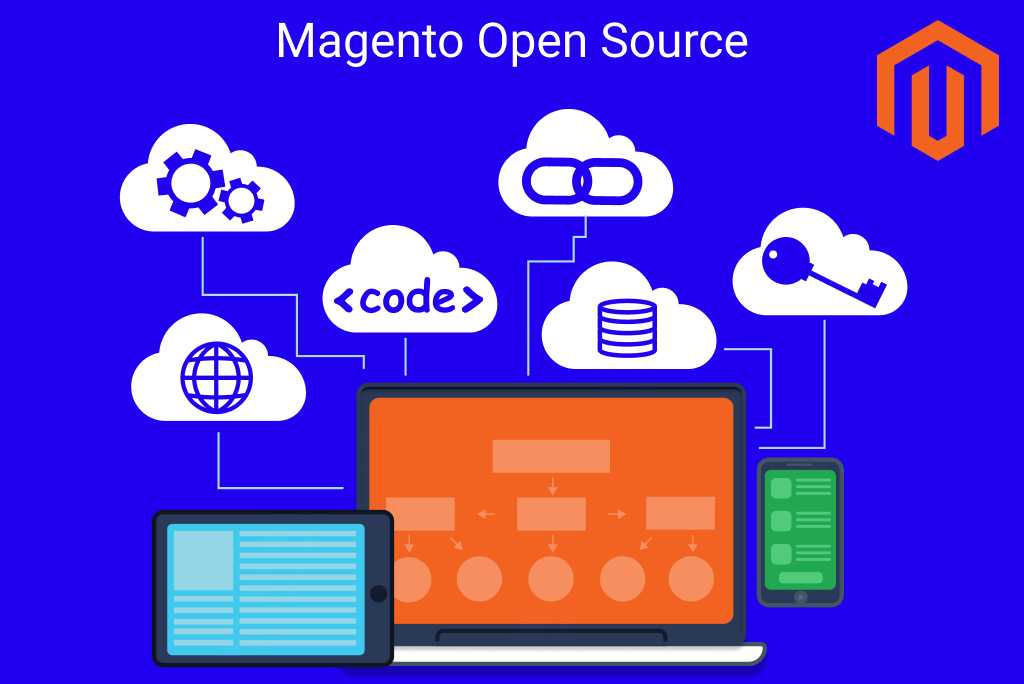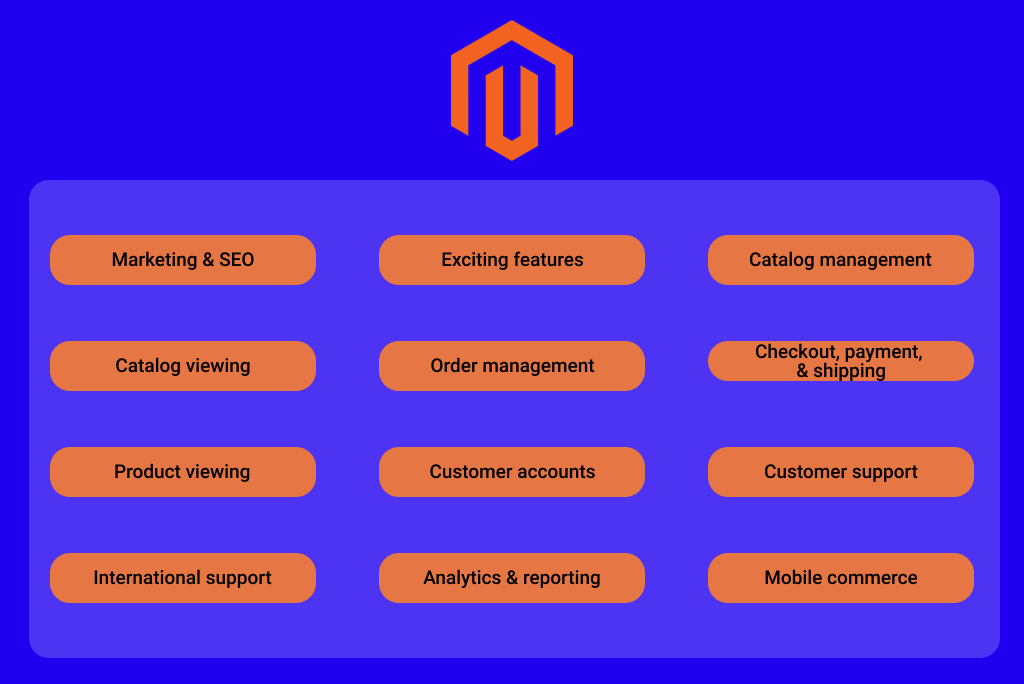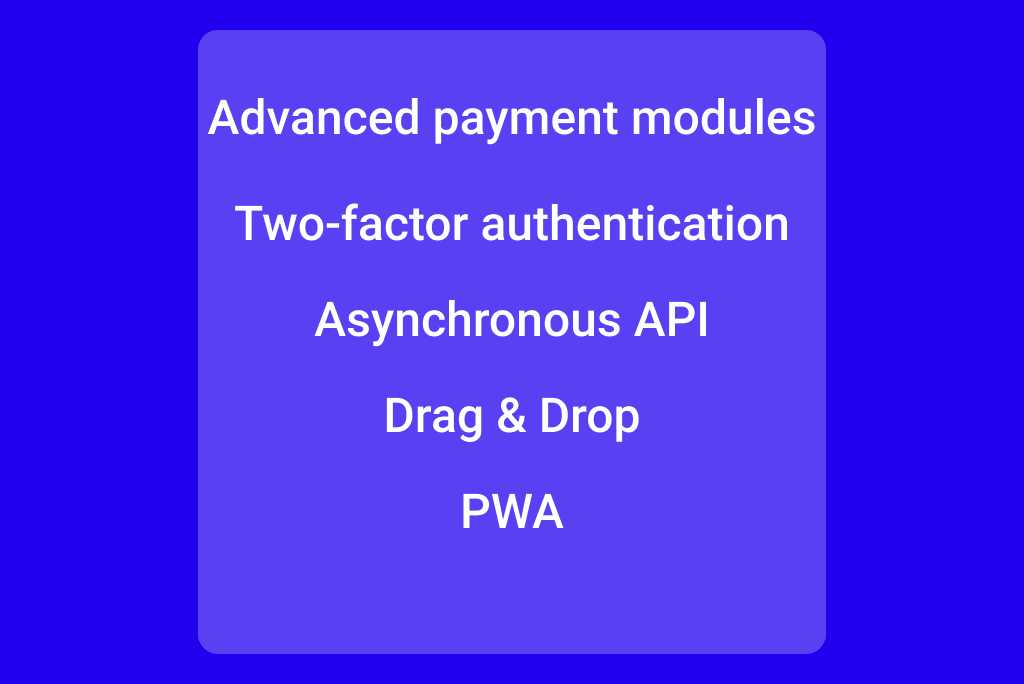Magento is a leading name among eCommerce platforms. Magento Open Source played a considerable role in its popularity and success.
Over the years, it became a driving engine for leading businesses like Christian Louboutin, Sergio Rossi, and Brand Alley. All these brands love Magento for being a free, flexible, and robust solution for eCommerce business.
In this article, we are going to overview all the Magento 2 features of the Open Source edition. You will learn about the main benefits the solution is offering, how it is different from Magento Commerce, and which Magento features are provided for free.
We have highlighted the following aspects:
- What is Magento Open Source?
- Magento 2 Open Source feature list
- key takeaways
What is Magento Open Source?
Magento Open Source is a version of the Magento platform that is distributed as a free-of-charge software. The platform was released in 2008 and, over the last few years, grew from a new solution to top positions. For the second year in a row Gartner, Inc. named Magento a leading eCommerce platform worldwide. It has gained full recognition among businesses of all sizes and locations.
A huge change happened at the end of 2015 when Magento 2 was released. The system got lots of fundamental changes like the increased speed of order processing, support of the latest version of PHP, and even features for more advanced SEO. Magento has made its platform more secure, drastically increased its performance, and turned it into a more user-friendly eCommerce solution.
Magento Features: Full Review of Open Source Edition
What is Magento used for?
Magento Open Source is known for being a robust eCommerce solution with a wide range of provided services. To save you time and make its benefits clear, we have created a full list of Magento 2 features:
- key functionality
- marketing and SEO
- catalog management
- catalog viewing
- product viewing
- checkout, payment, and shipping
- order management
- customer accounts
- customer support
- international support
- analytics and reporting
- mobile commerce
Go on reading to learn more about each of the highlighted points.
Magento 2 Features: Key Functionality
- PWA
This is probably one of the most exciting yet underestimated Magento 2 features. Magento PWA Studio was designed to help develop progressive web apps. It enables business owners to move to a new level when online stores get app-like user design and features, the ability to work offline and at low internet speed, and faster loading time as compared to eCommerce websites. The feature is also available for users of Magento Open Source.
- Drag & Drop
For merchants, this is one of the key Magento 2 features. It has made the creation of new website pages much easier. Magento 2 is integrated with BlueFoot CMS and Page Builder. These two solutions enabled the drag-and-drop features that do not require coding skills to add new pages to an online store.
- Advanced payment modules
By integrating its platform with Klarna, Magento has dramatically improved the shopping experience.
Among other benefits, Magento Open Source now supports split payments, instant checkout process, and enhanced product return/refund options.
- Asynchronous API
Among Magento 2 features that are worth mentioning, you can find asynchronous API. The main benefit is the reduction in server time response time. Overall, this improvement is essential for huge online stores that have hundreds or even thousands of products available.
- ElasticSearch
This Magento feature is also aimed to improve the customer experience. The integration of Magento with this search software enables more accurate and intuitive product searches. As a result, customers can find the products they are looking for faster, which increases the chances that they will proceed to the checkout process.
- Two-factor authentication
One of Magento 2 features enhances security with two-factor authentication. When enabled, the feature asks users to verify their identity by typing in an OTP that can be either sent to their email or mobile phone or be introduced in the form of a phone call.
Magento Features for Store Management
When you start working with Magento 2 Open Source, the first thing you notice is a user-friendly admin panel designed for easy site management. Here is everything it enables you to do:
- Create and control multiple eCommerce websites from a single admin panel
- Set roles, assign administrators, and grant permissions to various features
- Get access to the content management system that enables you to create website pages, content blocks, etc.
- Set support for multiple currencies, languages, and shipping methods
- Full tax rate management depending on location, type of product, wholesale or retail selling, etc.
- Integration with third-party services and technologies via APIs
- Import and export of product data and customer information in balk
- CAPTCHA protection from brute-force attacks
Magento 2 Features for Catalog Management
The list of eCommerce features of Magento 2 Open Source is huge and includes lots of valuable functionality for the management of product catalogs. Let’s look at Magento features of this type:
- Ability to set up different types of products: single, bundled, grouped, configurable (with variables such as size, color, etc.) and virtual
- Add an infinite number of products attributes
- Enable quick product creation by adding pre-defined sets of product attributes
- Easy management of inventory + support for backorders
- Timely notification for inventory replenishment so key products won’t run out of stock
- Set different options for out-of-stock message
- Limit the number of products that a user can add to the cart
- Batch update products by assigned values to multiple products
- Automatic resizing and watermarking of images
- Advanced pricing rules (create special prices, set prices for groups of customers, etc.)
- Search result redirection when customers get no results
- Add functionality for product customization with texts, images, etc.
Interested in knowing how much it will cost you to develop an eCommerce website?
Check out the article How Much Does a Magento 2 Website Cost: Editions, Services, & Additional Expenses where you will learn about all the factors that influence the development cost and how to calculate the price of your store.
Magento 2 Features for Catalog & Product Viewing
These Magento features allow easily browsing the catalog and product pages. They are designed to provide customers with an advanced search option that helps to find the needed products faster. As a result, lower cart abandonment and higher sales. Features for product and catalog viewing include the following options:
- Enable customers to filter products by categories, price range, brand, color, size, and other attributes
- Allow browsing products in grid or list format
- Add breadcrumbs, enable the history of viewed products and display a module for recently viewed ones
- Expand search results by supporting search synonyms suggestion
- Add multiple images per products and enable a zoom-in option
- Enable related products, up-sells, and cross-sells
- Add a “products in stock” tab, display pricing tiers, and available item options
- Enable the feature to share products on Facebook, Twitter, and other social media
- Set up the wish list functionality
Magento 2 Features for Checkout, Payment, & Shipping
With the latest version of Magento Open Source, a lot of features were added to create a smooth customer experience – from the first time customers open a website to the checkout process and beyond. Let’s investigate all the related Magento 2 features in more detail:
- Availability of one-page checkout process
- Allow shoppers to purchase without registering with your store
- Enable customers to send a single order to multiple addresses
- Automatically offer buyers to register an account as soon as they move to the check-out process
- Save the contents of the shopping cart
- Save credit card payment methods for offline payments
- Integrate with multiple PayPal gateways and add third-part payment and shipping modules through Magento Marketplace
- Automatically get shipping rates from major shipping companies like UPS, FedEx, etc.
- Show to which country you can ship an item based on the chosen shipping option
- Offer free shipping, add flat rate and table rates for shipping
- Allow customers to track their order from their customer accounts
Magento 2 Features for Order Management
After a customer places an order, behind-the-scenes work begins. The platform helps you automatically process orders and provides a variety of built-in Magento 2 features:
- Full order management from the admin panel with the provided features to view, edit, and fulfill orders
- Easily print automatically generated invoices, shipping labels, and packing slips
- Enable receiving order statuses via emails or through RSS feeds
- Allow customer support team to create orders, update the contents of shopping carts, and perform other order-related operation on requests from customers
Magento 2 Features for Customer Account & Customer Service
The customer account is an integral part of eCommerce websites. Magento Open Source provides a rich set of features to make it user-friendly and provide the necessary functionality:
- Create customer accounts that support a lot of features, including the functionality to view the status and history of orders, recently purchased products, etc.
- Allow to add default shipping addresses and to save an unlimited number of addresses
- Manage newsletter subscriptions and create shareable wish lists
- Browse submitted product and service reviews, and provide the Contact Us form
- Customize and send emails for order status, account updates, password changes, and other service emails
Wondering why big brands choose Magento?
Check out the article Why Use Magento: Main Reasons, Benefits, & Features. You will learn the main benefits of the eCommerce platform, which eCommerce websites it powers, and how to decide whether it is for you or not.
Magento Features for International eCommerce
This set of Magento Open Source features is especially important for sellers who operate in the international arena:
- Support for multiple languages, currencies and local tax rates, right to left text, accented characters, automatic product translation in French, German, Spanish, Dutch, Portuguese, and Chinese
- Predefine customers from which users can register with your store, order, and pay for purchases
- Support for fixed products taxes like DEEE/WEEE, VAT-ID 2, etc.
- Use cookie notification to comply with local laws
Magento 2 Features for Marketing & SEO
With Magento, you get access to a variety of built-in features that will help you to sell more. You can also perform SEO for better search ranking. Magento 2 Open Source feature list includes the following options:
- Set related products, up-sells, and cross-sells
- Bundle products
- Provide free shipping
- Easily set up and customize category landing pages
- Increase sales by showcasing recently viewed and compared items
- Create coupons and set promotional pricing for multiple stores, customer groups, product categories, etc.
- Export coupons to use them in emails, newsletters, coupon sites, etc.
- Track coupon usage and view analytics
- Create and distribute newsletters
- Enable product sharing via social media and in emails
- Automatically create a sitemap for better Google ranking
- Create optimized URLs and use URL rewrites
- Add metadata for products, categories, and other content pages
Magento 2 Features for eCommerce Analytics
Built-in analytics Magento 2 features help to make data-driven decisions and identify products that sell better and those that are not popular with customers.
- Full integration with Google Analytics
- In-depth reports on sales, taxes, abandoned carts, bestsellers, low stock, coupons usage, etc.
Magento Features for Mobile Commerce
In the time when mobile commerce is booming, Magento 2 features will make your store fully equipped to meet all the challenges:
- Create a responsive design
- Launch an eCommerce website that is optimized for any device
- Enjoy the benefits of better Google ranking and its preference for mobile-optimized sites first
- Send responsive email and newsletters, which users can read on any device
- Save on development and ongoing support
Features of Magento Open Source: Final Word
Magento is a powerful eCommerce solution that fuels thousands of online stores worldwide. Magento Open Source benefits are numerous, so are the features. The platform caters to the needs of small, medium and big eCommerce business that need:
- a reliable solution to power their stores
- high flexibility and customization
- unlimited performance and ability to scale
- a solution that can be used for free
- a popular platform with a wide community of developers
- regular security updates
- multiple currencies, languages, and shipping methods



















